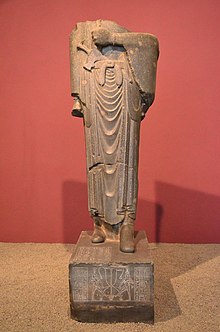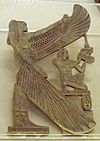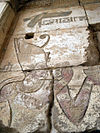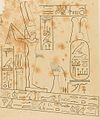525–404 BC Achaemenid province (satrapy)
The Svenigorodsky cylinder seal depicting a Persian king thrusting his lance at an Egyptian pharaoh, while holding four captives on a rope.[ 5] [ 6] [ 7] The Twenty-seventh Dynasty of Egypt (notated Dynasty XXVII , alternatively 27th Dynasty or Dynasty 27 ), also known as the First Egyptian Satrapy (Old Persian : Mudrāya [ 8] satrapy of the Achaemenid Empire between 525 and 404 BC. It was founded by Cambyses II , the King of Persia , after the Battle of Pelusium (525 BC) and the Achaemenid conquest of Egypt , and his subsequent crowning as Pharaoh of Egypt . It was disestablished upon the rebellion and crowning of Amyrtaeus as Pharaoh. A second period of Achaemenid rule in Egypt occurred under the Thirty-first Dynasty of Egypt (343–332 BC).
The last pharaoh of the Twenty-sixth Dynasty of Egypt , Psamtik III , was defeated by Cambyses II at the Battle of Pelusium in the eastern Nile delta in May of 525. Cambyses was crowned pharaoh in the summer of that year at the latest, beginning the first period of Persian rule over Egypt, known as the 27th Dynasty. Egypt was then joined with Cyprus and Phoenicia to form the sixth satrapy of the Achaemenid Empire , with Aryandes as the local satrap (provincial governor).
As Pharaoh of Egypt, Cambyses' reign saw the fiscal resources of traditional Egyptian temples diminished considerably. One decree, written on papyrus in demotic script , ordered a limitation on resources to all Egyptian temples, excluding Memphis , Heliopolis and Wenkhem (near Abusir ). Cambyses left Egypt sometime in early 522 BC, dying en route to Persia, and was nominally succeeded briefly by his younger brother Bardiya , although contemporary historians suggest Bardiya was actually Gaumata , an impostor, and that the real Bardiya had been murdered some years before by Cambyses, ostensibly out of jealousy. Darius I , suspecting this impersonation, led a coup against "Bardiya" in September of that year, overthrowing him and being crowned as King and Pharaoh the next morning.
As the new Persian King, Darius spent much of his time quelling rebellions throughout his empire. Sometime in late 522 BC or early 521 BC, a local Egyptian prince led a rebellion and declared himself Pharaoh Petubastis III . The main cause of this rebellion is uncertain, but the Ancient Greek military historian Polyaenus states that it was oppressive taxation imposed by the satrap Aryandes. Polyaenus further writes that Darius himself marched to Egypt, arriving during a period of mourning for the death of the sacred Herald of Ptah bull. Darius made a proclamation that he would award a sum of one hundred talents to the man who could produce the next Herald, impressing the Egyptians with his piety such that they flocked en masse to his side, ending the rebellion.[ 9]
Egyptian statue of Darius I , discovered in the Palace in Susa .[ 10] Modern impression of an Achaemenid cylinder seal from Iran , with king holding two lion griffins at bay and Egyptian hieroglyphs reading "Thoth is a protection over me". Circa 6th–5th century BC.[ 11] [ 12] Darius took a greater interest in Egyptian internal affairs than Cambyses. He reportedly codified the laws of Egypt, and notably completed the excavation of a canal system at Suez , allowing passage from the Bitter Lakes to the Red Sea , much preferable to the arduous desert land route. This feat allowed Darius to import skilled Egyptian laborers and artisans to construct his palaces in Persia. The result of this was a minor brain drain in Egypt, due to the loss of these skilled individuals, creating a demonstrable lowering of quality in Egyptian architecture and art from this period. Nevertheless, Darius was more devoted to supporting Egyptian temples than Cambyses, earning himself a reputation for religious tolerance in the region. In 497 BC, during a visit by Darius to Egypt, Aryandes was executed for treason, most likely for attempting to issue his own coinage, a visible attempt to distance Egypt from the rest of the Persian Empire.[ 13] [ 14] Xerxes I .
Egyptian soldier of the Achaemenid army, circa 470 BCE. Xerxes I tomb relief. Upon the accession of Xerxes, Egypt again rebelled, this time possibly under Psamtik IV , although different sources dispute that detail. Xerxes quickly quelled the rebellion, installing his brother Achaemenes as satrap. Xerxes ended the privileged status of Egypt held under Darius, and increased supply requirements from the country, probably to fund his invasion of Greece . Furthermore, Xerxes promoted the Zoroastrian god Ahura Mazda at the expense of traditional Egyptian deities, and permanently stopped the funding of Egyptian monuments. Xerxes was murdered in 465 BC by Artabanus , beginning a dynastic struggle that ended with Artaxerxes I being crowned the next King and Pharaoh.
In 460 BC another major Egyptian rebellion took place, led by a Libyan chief named Inaros II , substantially assisted by the Athenians of Greece.[ 15] Megabyzus in 454 BC and consequently sent into retreat. Megabyzus promised Inaros no harm would come of him or his followers if he surrendered and submitted to Persian authority, terms Inaros agreed to. Nevertheless, Artaxerxes eventually had Inaros executed, although exactly how and when is a matter of dispute.[ 16]
Artaxerxes successor, Xerxes II only ruled for forty-five days, being murdered by his brother Sogdianus . Sogdianus was consequently murdered by his brother Ochus, who became Darius II .[ 17] Artaxerxes II made attempts to begin an expedition to retake Egypt, but due to political difficulty with his brother Cyrus the Younger , abandoned the effort. Artaxerxes II was still recognized as the rightful Pharaoh in some parts of Egypt as late as 401 BC, although his sluggish response to the situation allowed Egypt to solidify its independence.
During the period of independent rule, three indigenous dynasties reigned: the 28th , 29th , and 30th Dynasty . Artaxerxes III (358 BC) reconquered the Nile valley for a brief second period (343 BC), which is called the 31st Dynasty of Egypt .
The Achaemenid rule over Egypt had been often viewed as either weak or oppressive. H. P. Colburn (2019) analyses suggest Achaemenid legacy there was significant and the Egyptians had a wide variety of experiences in this period.[ 18] [ 19]
Pharaohs of the 27th Dynasty [ edit ] Egyptian alabaster vase of Darius I with quadrilingual hieroglyphic and cuneiform inscriptions. The hieroglyph reads: "King of Upper and Lower Egypt, Lord of the Two Lands, Darius, living forever, year 36".[ 20] [ 21] The pharaohs of the 27th Dynasty ruled for approximately 121 years, from 525 BC to 404 BC. Rulers with violet background were native Egyptian pharaohs who rebelled against the Achaemenid rule.
[ edit ] Satraps of the 27th Dynasty [ edit ]
Name of satrap
Rule
Reigning monarch
Comments
Aryandes
525–522 BC;
Cambyses II, Darius I
Deposed following a revolt in 522 BC, later restored in 518 BC then deposed again by Darius I
Pherendates
c.496–c.486 BC
Darius I
Possibly killed during a revolt
Achaemenes
c.486–459 BC
Xerxes I, Artaxerxes I
A brother of Xerxes I, later killed by the rebel Inaros II
Arsames
c.454–c.406 BC
Artaxerxes I, Xerxes II, Artaxerxes II
Longest ruling satrap of Egypt
^ O'Brien, Patrick Karl (2002). Atlas of World History ISBN 9780195219210 ^ Philip's Atlas of World History ^ Davidson, Peter (2018). Atlas of Empires: The World's Great Powers from Ancient Times to Today ISBN 9781620082881 ^ Barraclough, Geoffrey (1989). The Times Atlas of World History ISBN 0723003041 ^ "a Persian hero slaughtering an Egyptian pharaoh while leading four other Egyptian captives" Hartley, Charles W.; Yazicioğlu, G. Bike; Smith, Adam T. (2012). The Archaeology of Power and Politics in Eurasia: Regimes and Revolutions ISBN 9781139789387
^ "Victor, apparently wearing the tall Persian headdress rather than a crown, leads four bareheaded Egyptian captives by a rope tied to his belt. Victor spears a figure wearing Egyptian type crown." in Root, Margaret Cool (1979). The king and kingship in Achaemenid art: essays on the creation of an iconography of empire ISBN 9789004039025
^ "Another seal, also from Egypt, shows a Persian king, his left hand grasping an Egyptian with an Egyptian hairdo (pschent), whom he thrusts through with his lance while holding four prisoners with a rope around their necks." Briant, Pierre (2002). From Cyrus to Alexander: A History of the Persian Empire ISBN 9781575061207
^ electricpulp.com. "ACHAEMENID SATRAPIES – Encyclopaedia Iranica" . www.iranicaonline.org . Retrieved 2017-09-30 . ^ Smith, Andrew. "Polyaenus: Stratagems - Book 7" . www.attalus.org . Retrieved 2017-02-25 . ^ Razmjou, Shahrokh (1954). Ars orientalis; the arts of Islam and the East 81 –101. ^ "Museum item, accession number: 36.106.2" . www.metmuseum.org . Metropolitan Museum of Art.^ Giovino, Mariana (2006). "Egyptian Hieroglyphs on Achaemenid Period Cylinder Seals". Iran . 44 . Iran, vol. 44: 105–114. doi :10.1080/05786967.2006.11834682 . JSTOR 4300705 . S2CID 193426061 . ^ electricpulp.com. "DARIUS iii. Darius I the Great – Encyclopaedia Iranica" . www.iranicaonline.org . Retrieved 2017-02-25 . ^ Klotz, David (19 September 2015). "UCLA Encyclopedia of Egyptology - Persian Period" . UCLA Encyclopedia of Egyptology . Retrieved 25 February 2017 . ^ Thucydides. History of the Peloponnesian War ^ Photius. "Photius' excerpt of Ctesias' Persica (2)" . www.livius.org . Retrieved 2017-02-25 . ^ S. Zawadzki, "The Circumstances of Darius II's Accession" in Jaarbericht Ex Oriente Lux 34 (1995-1996) 45-49
^ Colburn, Henry P. (2020). Archaeology of Empire in Achaemenid Egypt . Edinburgh University Press. ISBN 9781474452366 JSTOR 10.3366/j.ctvss3wvv . ^ Colburn, Henry Preater (2014). The Archaeology of Achaemenid Rule in Egypt (PhD thesis). hdl :2027.42/107318 ^ Goodnick Westenholz, Joan (2002). "A Stone Jar with Inscriptions of Darius I in Four Languages" (PDF) . ARTA : 2. ^ Qahéri, Sépideh (2020). "Alabastres royaux d'époque achéménide" . L’Antiquité à la BnF (in French). doi :10.58079/b8of .
Territories/[ 1] [ 2] [ 3] [ 4] [ 5]
Egypt Canaan Ebla Mari Kish /Assur Akshak /Akkad Uruk Adab Umma Lagash Ur Elam
4000–3200 BCE
Naqada I Naqada II Egypt-Mesopotamia relations
Pre-Dynastic period (4000–2900 BCE)
Susa I
Uruk period Anu Ziggurat , 4000 BCE)Susa II
3200–3100 BCE
Proto-Dynastic period Naqada III )
Upper Egypt Finger Snail Fish Pen-Abu Animal Stork Canide Bull Scorpion I Shendjw Iry-Hor Ka Scorpion II Narmer / Menes
Lower Egypt Hedju Hor Ny-Hor Hsekiu Khayu Tiu Thesh Neheb Wazner Nat-Hor Mekh Double Falcon Wash
3100–2900 BCE
Early Dynastic Period First Dynasty of Egypt Narmer Palette Narmer Menes Neithhotep ♀ (regent) Hor-Aha Djer Djet Merneith ♀ (regent) Den Anedjib Semerkhet Qa'a Sneferka Horus Bird Canaanites
Jemdet Nasr period Proto-Elamite period Susa III )
2900 BCE
Second Dynasty of Egypt Hotepsekhemwy Nebra/Raneb Nynetjer Ba Nubnefer Horus Sa Weneg-Nebty Wadjenes Senedj Seth-Peribsen Sekhemib-Perenmaat Neferkara I Neferkasokar Hudjefa I Khasekhemwy Early Dynastic Period I (2900–2700 BCE)
First Eblaite First kingdom of Mari Kish I dynastyJushur , Kullassina-bel Nangishlishma ,En-tarah-ana Babum , Puannum , Kalibum
2800 BCE
Kalumum Zuqaqip Atab Mashda Arwium Etana Balih En-me-nuna Melem-Kish Barsal-nuna Uruk I dynastyMesh-ki-ang-gasher
Enmerkar ("conqueror of Aratta ")
2700 BCE
Early Dynastic Period II (2700–2600 BCE)
Zamug , Tizqar , Ilku Iltasadum Lugalbanda Dumuzid, the Fisherman
Enmebaragesi ("made the land of Elam submit")[ 6]
Aga of Kish Gilgamesh Old Elamite period Indus-Mesopotamia relations
2600 BCE
Third Dynasty of Egypt Djoser Egyptian pyramids )Sekhemkhet Sanakht Nebka Khaba Qahedjet Huni
Early Dynastic Period III (2600–2340 BCE)
Sagisu Abur-lim Agur-lim Ibbi-Damu Baba-Damu
Kish II dynastyUhub Mesilim
Ur-Nungal Udulkalama Labashum Lagash En-hegal Lugal-
Ur A-Imdugud Ur-Pabilsag Meskalamdug Puabi )Akalamdug
Enun-dara-anna Mes-he Melamanna Lugal-kitun Adab Nin-kisalsi Me-durba Lugal-dalu
2575 BCE
Old Kingdom of Egypt Fourth Dynasty of Egypt Snefru Khufu Djedefre Khafre Bikheris Menkaure Shepseskaf Thamphthis Ur I dynasty Mesannepada
2500 BCE
Phoenicia (2500-539 BCE)
Second kingdom of Mari Ikun-Shamash Iku-Shamagan Ansud Sa'umu Ishtup-Ishar Ikun-Mari Iblul-Il Nizi
Kish III dynasty Ku-Baba ♀
Akshak dynasty Unzi Undalulu
Uruk II dynastyEnsha-
Mug-si
Umma I dynastyPabilgagaltuku
Lagash I dynastyUr-Nanshe Akurgal
A'annepada Meskiagnun Elulu Balulu
Awan dynasty Peli Tata Ukkutahesh Hishur
2450 BCE
Fifth Dynasty of Egypt Userkaf Sahure Neferirkare Kakai Neferefre Shepseskare Nyuserre Ini Menkauhor Kaiu Djedkare Isesi Unas
Enar-Damu Ishar-Malik
Ush Enakalle
Elamite invasions[ 6] Shushun- Napilhush
2425 BCE
Kun-Damu
Eannatum
2400 BCE
Adub-Damu Igrish-Halam Irkab-Damu
Kish IV dynastyPuzur-Suen Ur-Zababa
Urur
Lugal-kinishe-dudu Lugal-kisalsi
E-iginimpa'e Meskigal
Ur-Lumma Il Gishakidu Bara-irnun )
Enannatum Entemena Enannatum II Enentarzi
Ur II dynastyMesh-ki-ang-Nanna II
Kiku-siwe-tempti
2380 BCE
Sixth Dynasty of Egypt Teti Userkare Pepi I Merenre Nemtyemsaf I Pepi II Merenre Nemtyemsaf II Netjerkare Siptah Adab dynastyLugalannemundu
2370 BCE
Isar-Damu
Enna-Dagan Ikun-Ishar Ishqi-Mari
Invasion by Mari [ 6]
Ukush
Lugalanda Urukagina
Luh-ishan
2350 BCE
Puzur-Nirah Ishu-Il Shu-Sin
Uruk III dynastyLugalzagesi
2340 BCE
Akkadian Period (2340–2150 BCE)
Akkadian Empire Sargon of Akkad Rimush Manishtushu
Akkadian Governors: Eshpum Ilshu-rabi Epirmupi Ili-ishmani
2250 BCE
Naram-Sin Lugal-ushumgal
2200 BCE
First Intermediate Period Seventh Dynasty of Egypt Eighth Dynasty of Egypt Menkare Neferkare II Neferkare Neby Djedkare Shemai Neferkare Khendu Merenhor Neferkamin Nikare Neferkare Tereru Neferkahor Neferkare Pepiseneb Neferkamin Anu Qakare Ibi Neferkaure Neferkauhor Neferirkare
Second Eblaite
Third kingdom of Mari Shakkanakku Ididish Shu-Dagan Ishma-Dagan Shar-Kali-Sharri
Igigi , Imi , Nanum , Ilulu (3 years)Dudu Shu-turul
Uruk IV dynastyUr-nigin Ur-gigir
Lagash II dynastyPuzer-Mama Ur-Ningirsu I Pirig-me Lu-Baba Lu-gula Ka-ku Hishep-Ratep Helu Khita Puzur-Inshushinak
2150 BCE
Ninth Dynasty of Egypt Meryibre Khety Neferkare VII Nebkaure Khety Setut
Ur III period (2150–2000 BCE)
Nûr-Mêr Ishtup-Ilum Ishgum-Addu Apil-kin
Gutian dynasty La-erabum Si'um
Kuda (Uruk) Puzur-ili Ur-Utu
Umma II dynastyLugalannatum Ur-Baba Gudea Ur-Ningirsu Ur-gar Nam-mahani
Tirigan
2125 BCE
Tenth Dynasty of Egypt Meryhathor Neferkare VIII Wahkare Khety Merykare
Uruk V dynastyUtu-hengal
2100 BCE
(Vassals of UR III)
Iddi-ilum Ili-Ishar Tura-Dagan Puzur-Ishtar [ 7] Ur III dynasty Ur-Nammu Shulgi Amar-Sin Shu-Sin
2025-1763 BCE
Amorite invasionsIbbi-Sin
Elamite invasionsKindattu (Shimashki Dynasty )
Middle Kingdom of Egypt Eleventh Dynasty of Egypt Mentuhotep I Intef I Intef II Intef III Mentuhotep II Mentuhotep III Mentuhotep IV
Third Eblaite Amorites )Ibbit-Lim Immeya Indilimma
(Amorite Shakkanakkus )Hitial-Erra Hanun-Dagan Lim Dynasty of Mari Amorites )Yaggid-Lim Yahdun-Lim Yasmah-Adad Zimri-Lim (Queen Shibtu )
Old Assyria Puzur-Ashur I Shalim-ahum Ilu-shuma Erishum I Ikunum Sargon I Puzur-Ashur II Naram-Sin Erishum II
Isin-Larsa period Amorites )Dynasty of Isin Ishbi-Erra Shu-Ilishu Iddin-Dagan Ishme-Dagan Lipit-Eshtar Ur-Ninurta Bur-Suen Lipit-Enlil Erra-imitti Enlil-bani Zambiya Iter-pisha Ur-du-kuga Suen-magir Damiq-ilishu Dynasty of Larsa : Naplanum Emisum Samium Zabaia Gungunum Abisare Sumuel Nur-Adad Sin-Iddinam Sin-Eribam Sin-Iqisham Silli-Adad Warad-Sin Rim-Sin I (...) Rim-Sin II Uruk VI dynasty : Alila-hadum Sumu-binasa Naram-Sin of Uruk Sîn-kāšid Sîn-iribam Sîn-gāmil Ilum-gamil An-am Irdanene Rîm-Anum Nabi-ilišu
Sukkalmah dynasty Siwe-Palar-Khuppak
Twelfth Dynasty of Egypt Amenemhat I Senusret I Amenemhat II Senusret II Senusret III Amenemhat III Amenemhat IV Sobekneferu ♀
1800–1595 BCE
Thirteenth Dynasty of Egypt Fourteenth Dynasty of Egypt Abraham Biblical )Kings of Byblos Kings of Tyre Kings of Sidon
Yamhad Yamhad dynasty )Old Assyria (Shamshi-Adad dynastyShamshi-Adad I Ishme-Dagan I Mut-Ashkur Rimush Asinum Ashur-dugul Ashur-apla-idi Nasir-Sin Sin-namir Ipqi-Ishtar Adad-salulu Adasi Puzur-Sin Ashur-dugul Ashur-apla-idi Nasir-Sin Sin-namir Ipqi-Ishtar Adad-salulu Adasi Adaside dynasty Bel-bani Libaya Sharma-Adad I Iptar-Sin Bazaya Lullaya Shu-Ninua Sharma-Adad II Erishum III Shamshi-Adad II Ishme-Dagan II Shamshi-Adad III Ashur-nirari I Puzur-Ashur III Enlil-nasir I Nur-ili Ashur-shaduni Ashur-rabi I Ashur-nadin-ahhe I Enlil-Nasir II Ashur-nirari II Ashur-bel-nisheshu Ashur-rim-nisheshu Ashur-nadin-ahhe II
First Babylonian dynasty Amorites )Sumu-abum Sumu-la-El Sin-muballit Sabium Apil-Sin Sin-muballit Hammurabi Samsu-iluna Abi-eshuh Ammi-ditana Ammi-saduqa Samsu-Ditana Early Kassite rulers
Second Babylonian dynastySealand Dynasty ") Ilum-ma-ili Itti-ili-nibi Damqi-ilishu Ishkibal Shushushi Gulkishar m DIŠ+U-ENPeshgaldaramesh Ayadaragalama Akurduana Melamkurkurra Ea-gamil
Second Intermediate Period Sixteenth Dynasty Abydos Dynasty Seventeenth Dynasty
Fifteenth Dynasty of Egypt Hyksos ")Pharaoh Ahmose I slaying a Hyksos Semqen 'Aper-'Anati Sakir-Har Khyan Apepi Khamudi
Mitanni Kirta Shuttarna I Parshatatar
1531–1155 BCE
Tutankhamun New Kingdom of Egypt Eighteenth Dynasty of Egypt Ahmose I Amenhotep I
Third Babylonian dynasty (Kassites ) Agum-Kakrime Burnaburiash I Kashtiliash III Ulamburiash Agum III Karaindash Kadashman-harbe I Kurigalzu I Kadashman-Enlil I Burnaburiash II Kara-hardash Nazi-Bugash Kurigalzu II Nazi-Maruttash Kadashman-Turgu Kadashman-Enlil II Kudur-Enlil Shagarakti-Shuriash Kashtiliashu IV Enlil-nadin-shumi Kadashman-Harbe II Adad-shuma-iddina Adad-shuma-usur Meli-Shipak II Marduk-apla-iddina I Zababa-shuma-iddin Enlil-nadin-ahi
Middle Elamite period
(1500–1100 BCE)Kidinuid dynasty Igehalkid dynasty Untash-Napirisha
Thutmose I Thutmose II Hatshepsut ♀ Thutmose III
Amenhotep II Thutmose IV Amenhotep III Akhenaten Smenkhkare Neferneferuaten ♀ Tutankhamun Ay Horemheb
Hittite Empire Ugarit
Nineteenth Dynasty of Egypt Ramesses I Seti I Ramesses II Merneptah Amenmesses Seti II Siptah Twosret ♀
Elamite Empire Shutrukid dynasty Shutruk-Nakhunte
1155–1025 BCE
Twentieth Dynasty of Egypt Setnakhte Ramesses III Ramesses IV Ramesses V Ramesses VI Ramesses VII Ramesses VIII Ramesses IX Ramesses X Ramesses XI Third Intermediate Period Twenty-first Dynasty of Egypt Smendes Amenemnisu Psusennes I Amenemope Osorkon the Elder Siamun Psusennes II
Phoenicia Kings of Byblos Kings of Tyre Kings of Sidon Kingdom of Israel Saul Ish-bosheth David Solomon
Syro-Hittite states Middle Assyria Eriba-Adad I Ashur-uballit I Enlil-nirari Arik-den-ili Adad-nirari I Shalmaneser I Tukulti-Ninurta I Ashur-nadin-apli Ashur-nirari III Enlil-kudurri-usur Ninurta-apal-Ekur Ashur-dan I Ninurta-tukulti-Ashur Mutakkil-Nusku Ashur-resh-ishi I Tiglath-Pileser I Asharid-apal-Ekur Ashur-bel-kala Eriba-Adad II Shamshi-Adad IV Ashurnasirpal I Shalmaneser II Ashur-nirari IV Ashur-rabi II Ashur-resh-ishi II Tiglath-Pileser II Ashur-dan II
Fourth Babylonian dynasty ("Second Dynasty of Isin ") Marduk-kabit-ahheshu Itti-Marduk-balatu Ninurta-nadin-shumi Nebuchadnezzar I Enlil-nadin-apli Marduk-nadin-ahhe Marduk-shapik-zeri Adad-apla-iddina Marduk-ahhe-eriba Marduk-zer-X Nabu-shum-libur
Neo-Elamite period (1100–540 BCE)
1025–934 BCE
Fifth, Sixth, Seventh, Babylonian dynasties ("Period of Chaos") Simbar-shipak Ea-mukin-zeri Kashshu-nadin-ahi Eulmash-shakin-shumi Ninurta-kudurri-usur I Shirikti-shuqamuna Mar-biti-apla-usur Nabû-mukin-apli
911–745 BCE
Twenty-second Dynasty of Egypt Shoshenq I Osorkon I Shoshenq II Takelot I Osorkon II Shoshenq III Shoshenq IV Pami Shoshenq V Pedubast II Osorkon IV Twenty-third Dynasty of Egypt Harsiese A Takelot II Pedubast I Shoshenq VI Osorkon III Takelot III Rudamun Menkheperre Ini Twenty-fourth Dynasty of Egypt Tefnakht Bakenranef
Kingdom of Samaria Kingdom of Judah
Neo-Assyrian Empire Adad-nirari II Tukulti-Ninurta II Ashurnasirpal II Shalmaneser III Shamshi-Adad V Shammuramat ♀ (regent) Adad-nirari III Shalmaneser IV Ashur-Dan III Ashur-nirari V
Eight Babylonian Dynasty Ninurta-kudurri-usur II Mar-biti-ahhe-iddina Shamash-mudammiq Nabu-shuma-ukin I Nabu-apla-iddina Marduk-zakir-shumi I Marduk-balassu-iqbi Baba-aha-iddina (five kings) Ninurta-apla-X Marduk-bel-zeri Marduk-apla-usur Eriba-Marduk Nabu-shuma-ishkun Nabonassar Nabu-nadin-zeri Nabu-shuma-ukin II Nabu-mukin-zeri Humban-Tahrid dynasty Urtak Teumman Ummanigash Tammaritu I Indabibi Humban-haltash III
745–609 BCE
Twenty-fifth Dynasty of Egypt Taharqa Black Pharaohs ")Piye Shebitku Shabaka Taharqa Tanutamun
Neo-Assyrian Empire (Sargonid dynasty ) Tiglath-Pileser † Shalmaneser † Marduk-apla-iddina II Sargon † Sennacherib † Marduk-zakir-shumi II Marduk-apla-iddina II Bel-ibni Ashur-nadin-shumi † Nergal-ushezib Mushezib-Marduk Esarhaddon † Ashurbanipal Ashur-etil-ilani Sinsharishkun Sin-shumu-lishir Ashur-uballit II
Assyrian conquest of Egypt
Assyrian conquest of Elam
626–539 BCE
Late Period Twenty-sixth Dynasty of Egypt Necho I Psamtik I Necho II Psamtik II Wahibre Ahmose II Psamtik III
Neo-Babylonian Empire Nabopolassar Nebuchadnezzar II Amel-Marduk Neriglissar Labashi-Marduk Nabonidus
Median Empire Deioces Phraortes Madyes Cyaxares Astyages
539–331 BCE
Twenty-seventh Dynasty of Egypt First Achaemenid conquest of Egypt )
Kings of Byblos Kings of Tyre Kings of Sidon
Achaemenid Empire Cyrus Cambyses Darius I Xerxes Artaxerxes I Darius II Artaxerxes II Artaxerxes III Artaxerxes IV Darius III
Twenty-eighth Dynasty of Egypt Twenty-ninth Dynasty of Egypt Thirtieth Dynasty of Egypt
Thirty-first Dynasty of Egypt
331–141 BCE
Argead dynasty and Ptolemaic Egypt Ptolemy I Soter Ptolemy Keraunos Ptolemy II Philadelphus Arsinoe II ♀ Ptolemy III Euergetes Berenice II Euergetis ♀ Ptolemy IV Philopator Arsinoe III Philopator ♀ Ptolemy V Epiphanes Cleopatra I Syra ♀ Ptolemy VI Philometor Ptolemy VII Neos Philopator Cleopatra II Philometor Soter ♀ Ptolemy VIII Physcon Cleopatra III ♀ Ptolemy IX Lathyros Cleopatra IV ♀ Ptolemy X Alexander Berenice III ♀ Ptolemy XI Alexander Ptolemy XII Auletes Cleopatra V ♀ Cleopatra VI Tryphaena ♀ Berenice IV Epiphanea ♀ Ptolemy XIII Ptolemy XIV Cleopatra VII Philopator ♀ Ptolemy XV Caesarion Arsinoe IV ♀
Hellenistic Period Seleukos I Nikator Tetradrachm from Babylon Argead dynasty Alexander III Philip III Alexander IV Antigonid dynasty Antigonus I Seleucid Empire Seleucus I Antiochus I Antiochus II Seleucus II Seleucus III Antiochus III Seleucus IV Antiochus IV Antiochus V Demetrius I Alexander III Demetrius II Antiochus VI Dionysus Diodotus Tryphon Antiochus VII Sidetes
141–30 BCE
Kingdom of Judea Simon Thassi John Hyrcanus Aristobulus I Alexander Jannaeus Salome Alexandra ♀ Hyrcanus II Aristobulus II Antigonus II Mattathias
Alexander II Zabinas Seleucus V Philometor Antiochus VIII Grypus Antiochus IX Cyzicenus Seleucus VI Epiphanes Antiochus X Eusebes Antiochus XI Epiphanes Demetrius III Eucaerus Philip I Philadelphus Antiochus XII Dionysus Antiochus XIII Asiaticus Philip II Philoromaeus
Parthian Empire Mithridates I Phraates Hyspaosines Artabanus Mithridates II Gotarzes Mithridates III Orodes I Sinatruces Phraates III Mithridates IV Orodes II Phraates IV Tiridates II Musa Phraates V Orodes III Vonones I Artabanus II Tiridates III Artabanus II Vardanes I Gotarzes II Meherdates Vonones II Vologases I Vardanes II Pacorus II Vologases II Artabanus III Osroes I
30 BCE–116 CE
Roman Empire
(Roman conquest of Egypt )Province of Egypt
Judea
Syria
116–117 CE
Province of Mesopotamia under Trajan
Parthamaspates of Parthia
117–224 CE
Syria Palaestina
Province of Mesopotamia
Sinatruces II Mithridates V Vologases IV Osroes II Vologases V Vologases VI Artabanus IV
224–270 CE
Sasanian Empire Province of Asoristan Coin of Ardashir I, Hamadan mint. Ardashir I Shapur I Hormizd I Bahram I Bahram II Bahram III Narseh Hormizd II Adur Narseh Shapur II Ardashir II Shapur III Bahram IV Yazdegerd I Shapur IV Khosrow Bahram V Yazdegerd II Hormizd III Peroz I Balash Kavad I Jamasp Kavad I Khosrow I Hormizd IV Khosrow II Bahram VI Chobin Vistahm
270–273 CE
Palmyrene Empire Vaballathus Zenobia ♀ Antiochus
273–395 CE
Roman Empire
Province of Egypt
Syria Palaestina
Syria
Province of Mesopotamia
395–618 CE
Byzantine Empire
Byzantine Egypt
Palaestina Prima , Palaestina Secunda
Byzantine Syria
Byzantine Mesopotamia
618–628 CE
(Sasanian conquest of Egypt )Province of Egypt Shahrbaraz Sahralanyozan Shahrbaraz
Sasanian Empire Province of Asoristan Khosrow II Kavad II
628–641 CE
Byzantine Empire Ardashir III Shahrbaraz Khosrow III Boran ♀ Shapur-i Shahrvaraz Azarmidokht ♀ Farrukh Hormizd Hormizd VI Khosrow IV Boran Yazdegerd III Peroz III Narsieh
Byzantine Egypt
Palaestina Prima , Palaestina Secunda
Byzantine Syria
Byzantine Mesopotamia
639–651 CE
Muslim conquest of Egypt Muslim conquest of the Levant Muslim conquest of Mesopotamia and Persia
Chronology of the Neolithic period
Rulers of Ancient Central Asia






























